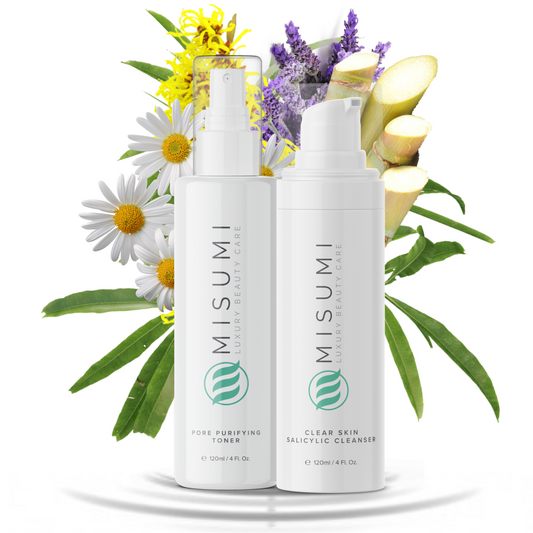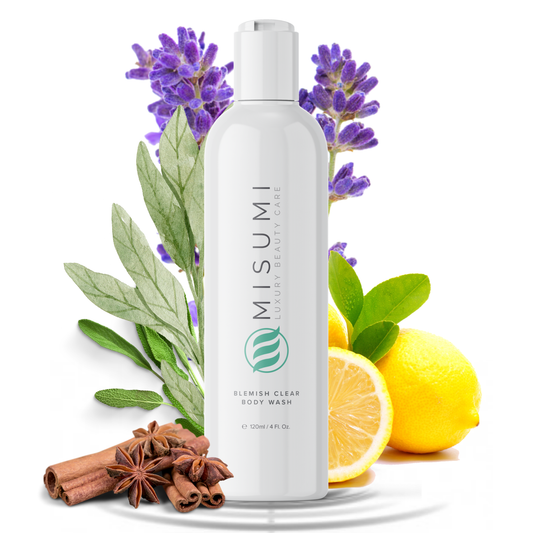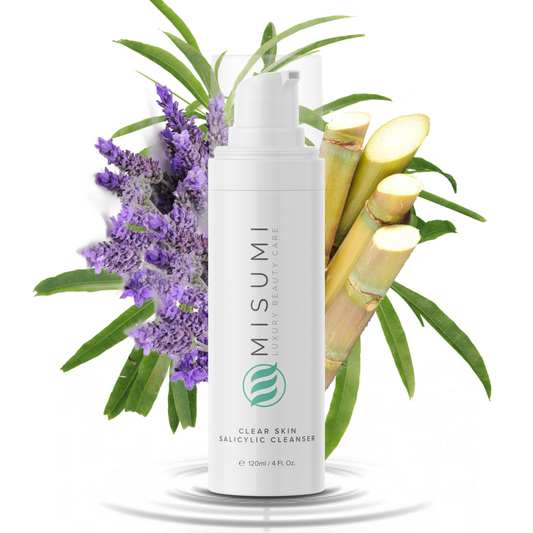Chamomile might be your favorite tea, but this magnificent herb is so much more than that. Chamomile can be used for hair, digestive problems, stress relief, and, of course, a good night's sleep. Not to mention, the chamomile benefits for skin are many. It seems like there's nothing chamomile can't do, which is quite understandable given that its uses are documented as far back as ancient Egyptian times.
In folk culture, chamomile is associated with purification and protection, which is why it's usually used in incense for sleep and meditation.
In today's modern world, with its scientifically driven medical and cosmetic industries, chamomile finds its place as a disease-fighting, pain-relieving, and anti-inflammatory ingredient. There might be other amazing skincare products out there (like Misumi's Complete Clear 3-Step System), but there's a reason why chamomile has lasted so long.
Let's start at the beginning and see what makes chamomile so special. We'll explore its benefits and uses for the skin in depth.
What Do We Know About Chamomile?

We know that chamomile has anti-inflammatory, deodorant, bacteriostatic, antimicrobial, sedative, and antiseptic properties. In skin care, it's used for healing and pain relief. It can help with skin irritation, dermatitis, eczema, and cracked skin.
Chamomile plants are a member of the Asteraceae family. There are two types of chamomile herbs commonly used in skincare.
Roman Chamomile (Chamaemelum nobile) and German Chamomile (Matricaria chamomilla) are both aromatic herbs often used interchangeably. But, if you google the chamomile benefits for skin, you'll probably get products, essential oils, and homemade recipes branded as this
Here are the fundamental differences between them, although they're both used in cosmetics.
German Chamomile Vs Roman Chamomile
Both types of herbs are grown and commercially sold as "chamomile" because they have similar, if not the same, properties. Both Roman and German chamomile have anti-spasmodic, anti-inflammatory, anti-fungal, and anti-bacterial properties. They're used in medicine as mild tranquilizers or sedatives.
Most differences between the plants can be found in their morphology and chemical composition.
What Makes Chamomile Such a Great Plant For Skincare?

Chamomile contains a lot of active ingredients that help the skin heal.
Bisabolol
Bisabolol is natural monocyclic sesquiterpene alcohol. It's the compound that helps the plant protect itself from fungal attacks. It's really an amazing little compound. It has anti-inflammatory, antibacterial, anti-irritant, anti-fungal, and non-allergenic properties. It promotes tissue regeneration and has the ability to increase the absorption of other products on the skin.
Because of this, bisabolol is recommended in cosmetic preparations. Bisabolol is found in both types of chamomile, although it's more concentrated in the German plant.
Chamazulene
Chamazulene provides an additional anti-inflammatory property to chamomile herbs. It's found in both German and Roman chamomile essential oils, and it's responsible for their blue color.
Apigenin
Apigenin is a flavonoid compound that's also found in both types of chamomile flowers, but as opposed to chamazulene, it's not present in essential oil. It's a highly potent anti-inflammatory ingredient that is building a reputation as a mighty cancer-fighting agent. In a lot of scientific studies, apigenin has shown effectiveness against a wide range of cancer types without showing toxicity.
In a scientific review from 2010, the authors concluded that there is considerable potential for apigenin to be developed as a cancer chemo-preventive agent.
Also, in a more recent study from 2017, published in the journal Cell&Bioscience, it was again proved that apigenin is a promising reagent for cancer therapy.
Benefits of Using Chamomile For Skin

High Source Of Antioxidants
All three of the main active ingredients in chamomile (bisabolol, chamazulene, apigenin) have potent antioxidative power. This means that chamomile can balance free radicals and prevent oxidative stress.
Our body generates free radicals every time it's exposed to some kind of damage. These can alter lipids, proteins, and DNA and trigger many diseases. When the body can't control them, and they overwhelm it, a state called oxidative stress occurs. This is why a balance between free radicals and antioxidants is necessary for the optimal physiological functioning of our body. And, sometimes, an external source of antioxidants is needed to help the body and skin heal. Here's where chamomile helps a lot.
To better understand how antioxidants promote skin health,
where you can find them, what the benefits for skin are and how to use them, check out our article, where we go into more detail.
The high levels of phenolic contents, antioxidant and antimicrobial activities in chamomile were proved in a study published in the journal of Industrial Crops and Products.
Additionally, another study from the same journal in 1993 compared the antioxidant and antibacterial properties of Mediterranean aromatic plants. The results showed that Roman chamomile essential oil exhibited the highest antioxidant activity.
In 2015 in the Journal of Chromatography A, yet another study compared the antioxidant activity in calendula, feverfew, and German chamomile extracts. The authors found that extracts from chamomile flower heads and leaves have the most prominent antioxidant activity, with bisabolol and chamazulene being the most effective antioxidants.
With this highly antioxidative potential, it's only natural that we see chamomile as a part of so many skincare products, creams, body lotions, toners, gels, and even baby wipes. Chamomile is so gentle that it's considered safe for baby skin and can soothe sensitive skin types.
As natural ingredients are the backbone of Misumi's skincare products, you can find chamomile extracts in many of their products, the gentle skin-perfecting cleanser being the perfect example.

Potent Anti-inflammatory Properties
Although there's not much research on chamomile to explore its skincare benefits in-depth, the properties of this herb are well-known and documented.
Inflammation is an immune system reaction to fight infection, and it's believed that chamomile contains chemical compounds that may reduce inflammation.
A review of the bioactivity and potential health benefits of chamomile tea, published in the journal of Phytotherapy Research in 2006, found that animal studies indicate potent anti-inflammatory action, some antimutagenic and cholesterol‐lowering activities, as well as antispasmodic and anxiolytic effects.
Drinking chamomile tea can lower inflammation in the body and improve your overall health, while applying chamomile topically can lower the inflammation in the skin and reduce blemishes, aggravated pimples, and other skin irritations.

Pain Reducing Abilities
Chamomile is like an herbal aspirin, so don't be surprised if you find chamomile in many homemade recipes for soothing the skin and relieving pain. (Just don't use it with a real aspirin, as it can cause side effects).
One 2018 study from the official Journal of The Italian Neurological Society evaluated the effect of using chamomile topically as pain relief in migraine without aura. The results from the study showed that pain, nausea, vomiting, photophobia, and phonophobia significantly decreased only 30 minutes after applying chamomile to the patients. The researchers concluded that this study supports the efficacy of chamomile oleogel as pain relief in migraine without aura.
Helps With Acne Conditions
The soothing and calming effects chamomile has on the skin can be really beneficial for helping inflamed pimples, and frequent acne breakouts heal faster.
Since chamomile is high in antioxidants, it can be a good natural and gentle ingredient to add to your anti-acne agents.
The antioxidants scavenge free radicals and protect from free radical damage, while the anti-inflammatory properties reduce irritation, redness, and swelling, making the pimples less visible.
It also has mild astringent and brightening properties that can help with skin redness and skin lightening.
Keep in mind that chamomile is really gentle and mild. It would be an amazing addition to your stronger and more aggressive anti-acne skin care routine. It also soothes sensitive skin after using anti-acne products.
That being said, don't expect your acne to go away by using chamomile tea on your face. And speak to a doctor before using chamomile tea or essential oil on damaged skin.

Helps With Eczema
Topical application of chamomile extracts has shown to be an effective treatment for atopic eczema. One study discovered that it's about 60% as effective as 0.25% hydrocortisone cream. According to the findings of the study, Roman chamomile of the Manzana type (Kamillosan (R)) may ease the discomfort associated with eczema when applied as a cream containing chamomile extract. Nevertheless, the authors warn that further research is needed to evaluate the usefulness of topical chamomile in managing eczema.
Wound Healing Abilities
Topical use of chamomile can also be really beneficial in the process of wound healing.
The efficacy of the topical use of chamomile to enhance healing was evaluated in a double-blind trial on 14 patients who underwent dermabrasion of tattoos. The results showed that chamomile is significantly effective in producing wound drying and in speeding epithelialization.
One animal study on rats, published in the Journal of Wound Care, also evaluated the wound-healing properties of M. Recutita (chamomile) extract. According to the results, the increased rate of wound contraction, together with the increased wound-breaking strength, hydroxyproline content, and histological observations, support the use of M. Recutita in wound management.
But, maybe the most impressive results come from an in-vitro and in-vivo comparative analysis of chamomile and corticosteroids for treating ulcers. The study was done on male rats where it was observed that all animals of the chamomile group exhibited complete wound healing 9 days before the other groups. Completely repaired lesions were observed after 5 days of treatment only in the chamomile group. The researchers concluded that chamomile, in comparison to corticosteroids, promotes a faster wound-healing process.

Treating Sunburns
Chamomile reportedly can help in relieving pain, swelling, redness, and itchiness from a nasty sunburn. The powerful anti-inflammatory and antioxidative properties can calm the skin, reduce skin inflammation, and help treat wounds from UV exposure heal faster.
Nonetheless, try not to get to the point where you'll need chamomile for sunburned skin. Invest in high-quality sunscreen and protect the skin from damage and premature aging.
Other Scientifically-Supported Benefits of Using Chamomile:
- Anti-cancer activity and potential component in the anti-cancer treatment.
- Fights off the common cold. Inhaling steam with chamomile extract can help alleviate cold symptoms.
- Helps with some cardiovascular conditions.
- Soothes and decreases discomfort from gastrointestinal conditions.
- Improves hemorrhoids.
- Can act as a powerful sedative and promotes sleep quality.
- Helps with anxiety and panic attacks.
Side-Effects and Precautions of Using Chamomile For Skin

The U. S. Food and Drug Administration (FDA) has classified Roman and German chamomile oil application as Generally Regarded As Safe (GRAS). Nevertheless, there are a few precautions when using chamomile for glowing skin.
Drug Interactions
You shouldn't be consuming chamomile along with analgesic drugs like aspirin and other non-salicylate NSAIDs (non-steroidal anti-inflammatory drugs), because there might be a herb-drug interaction.
One study from 2002 reviewed the potential adverse interactions of the commonly used herbal supplements, including chamomile and analgesic drugs. The researchers warn against the use of aspirin and other NSAIDs with herbal supplements that possess antiplatelet activity, coumarin (chamomile and several others), or tamarind because there might be an increased risk of bleeding.
Additionally, an interaction between chamomile and cyclosporine, as well as warfarin, have also been reported. Cyclosporine is a drug that prevents the rejection of organ transplants, while warfarin is a blood-thinner drug.
Talk to your doctor before using chamomile because these interactions might cause complications.

Allergy
Chamomile is considered a very gentle plant. Nevertheless, allergic reactions have been reported. If you're allergic to ragweed, chrysanthemums, marigolds, or daisies, you may also be allergic to chamomile.
Just like with any other skincare products, before using chamomile or skincare products containing chamomile, do a patch test. Don't risk it.
Pregnancy
Avoid chamomile during pregnancy. It's believed that the plant can cause uterine contractions, which can provoke a miscarriage. Although research is very thin, it's best if you stay away from it during this vulnerable time.
Talk to your healthcare provider or gynecologist before using chamomile during pregnancy.
How to Use Chamomile in Your Daily Skincare Routine
Soul Soothing Bath With Chamomile And Lavender
Adding chamomile to your bath is a popular way to soothe the skin, calm irritated skin, rashes, or redness on the skin, and even fight off vaginal infections. And why rub chamomile on your skin when you can soak it in chamomile water and relax?
Some sources claim that soaking in a chamomile bath every day for about eight weeks can help reduce anxiety, maybe even more than by taking medications.
Ingredients:
- 1 cup of almond oil
- 1 teaspoon of chamomile
- 1 teaspoon of lavender essential oil
Method:
It's actually really simple. Take one bottle, add the ingredients and shake them well. After this, just pour them in the water, and you've made yourself a chamomile bath! Depending on how big your bath is, feel free to double the quantities of the ingredients.

Chamomile Oil And Oatmeal Mask For Dry Skin
If you feel like your skin needs that extra moisture to really glow, run to your local supermarket and get the ingredients you need to make an all-natural, homemade mask for dry skin. Add this to your skincare regime - it will soften skin and help prevent signs of aging.
Ingredients:
- ¼ cup of cooked oatmeal
- 2 tbsp of almond or avocado carrier oil
- 3 drops of chamomile roman oil
- 1 egg yolk
Method:
Mix the ingredients in one small bowl and stir until you get a smooth paste-like consistency. You can start by adding only a portion of the oatmeal and then slowly add the rest to have better control over the consistency of the paste.
After everything is nicely blended, clean your hands and apply it gently over the face. Cover your whole face, but avoid the area around the eyes. Let the mask sit for 10-15 minutes, and then rinse off with lukewarm water.
Always finish the routine with a moisturizer.

Chamomile & Honey Mask to Treat Acne
Ingredients:
- 1 tbsp of dry chamomile or chamomile oil
- 1 tbsp of honey
- 1 tbsp of freshly squeezed lemon juice
- 1 egg white
Method:
If you're using dry chamomile, pour hot water over the herbs and wait for 20 minutes to infuse. After this, filter the herbs from the water. In a small container, add all the ingredients along with 2-3 tbsp of the chamomile water you made.
If you want the mask to be more gentle, you can add more chamomile water. Anyway, after blending the ingredients and getting a smooth paste, apply the mask on a clean face and leave it on for 15-20 minutes.
In the end, wash your face with warm water and apply a moisturizer.
When applied topically, this mask will help the appearance of acne-prone skin and acne scars, and underlying inflammation, giving you a youthful glow.

Refreshing Chamomile & Aloe Vera Gel Mask
Ingredients:
- 2 teaspoons of cosmetic clay
- 1 teaspoon of honey
- 1 teaspoon of aloe vera gel
- Infused chamomile water
Method:
Mix the chamomile water with the clay until you get a smooth paste. If you need to, add more chamomile to adjust the consistency. Then, add the honey and aloe vera gel and mix again.
When the paste is well blended, you can apply it directly on your face. Make sure you cleanse first. Your face needs to be clean. Leave the mask on to act for about 15 minutes and then wash off with lukewarm water to get a healthy glow.
Tea Bags on the Eyes to Reduce Dark Circles
If you're feeling under stress, haven't slept right, or maybe you partied too hard the other night, and now you're faced with big dark circles, chamomile will come to the rescue.
Make tea and drink it. It will help you from the inside out and improve your overall health. In the meantime, don't throw away the tea bags you used to make the tea with. Instead, let them dry a little and come to room temperature. When you feel they've reached room temperature, apply each tea bag over your eyes and fest for 10 to 20 minutes.
The chamomile will help your skin fight off oxidative stress and reduce inflammation.
References
Apigenin: A Promising Molecule for Cancer Prevention
Antioxidant and antimicrobial activities of essential oil and extracts of fennel
Antibacterial and antioxidant properties of Mediterranean aromatic plants
A Review of the bioactivity and potential health benefits of chamomile tea
Chamomile: A herbal medicine of the past with bright future
Effect of chamomile on wound healing
Wound healing activity of Matricaria recutita L. extract
Comparative analysis between Chamomilla recutita and corticosteroids on wound healing
Herbal medication: potential for adverse interactions with analgesic drugs










